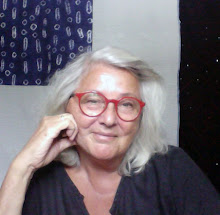Judy Martin's work is featured in Claire Wellesley-Smith's new book, Slow Stitch: Mindful and Contemplative Textile Art.
It is published by Batsford and distributed in USA and Canada by Sterling Publishing Company. This beautiful hard covered book can be purchased from your local bookshop or online.
The book explores a slow approach to stitching on cloth. The pleasures to be had from slowing down processes are multiple, with connections to ideas of sustainability, simplicity, reflection and multicultural textile traditions. (from the introduction by the author)
Judy's work is pictured on page 96 and 97 with the accompanying text.
Canadian textile artist Judy Martin uses the idea of daily practice in her monumental work Not To Know But To Go On (the name of the piece taken from the writings of artist Agnes Martin). For three years she used her practice as one might use the daily ritual of writing a diary. The design of the piece refers to her Finnish cultural heritage of rag-rug making (although the piece is stitched not woven). Every day one complete skein of stranded cotton embroidery thread was couched over strips of found fabric from her own collection on to a cotton canvas backing. She says, "Stitching gets me up in the morning. I look forward to spending that quiet time with myself. It's emotional therapy, as I stitch, other things fall into place; the time it takes helps me to be quiet. Inner time goes backwards and forwards. Time is recycled."
The Manitoulin Circle Project is pictured on pages 116 and 117 with the accompanying text.
Canadian artist Judy Martin worked with over 140 people during the four year Manitoulin Circle Project. Four large 'meditation panels' were created during the project: Earth Ark, Precious Water, Layers of Time and Mended World. Each panel carries the message of environmental appreciation and reparation. The work was largely made from donated and charity-shop materials: damask tablecloths and other domestic textiles, including crocheted doilies, women's handkerchiefs and wool blankets. A theme of re-creation and also of reparation through the remaking of these materials ran through the project. Every week during the four years of the project participants gathered in a church hall to work on the pieces, building community and personal friendships as they slowly created their pieces of work.
The Mended World panel is constructed using a string-piecing technique. Using a sewing machine, four or five long narrow strips of a variety of textured damasks (from recycled tablecloths) were sewn together along their long edges to create a new striped fabric. This fabric is then re-cut several times and sewn back toether to make a wide piece of new fabric.
The project speaks of time and has produced beautiful, meaningful work. as an artist who works with communities, i am always deeply moved when I think about the other work that goes into producing pieces like this. The other work is the conversation, the communication, the slowing getting to know one's stitching neighbour, the memories and skills shared, and the hours of committed thought and organization of the facilitator/artist. Somehow the tactile cloth holds all of this within its folds, layers and stitches. This work is a reminder that people and places mixed together, and the exchanges they have, can produce satisfying results.
Other artists featured in the book include:
Abigail Doan
Kate Bowles
Alice Fox
Pat Fuller
Lotta Helleberg
Roz Hawker
Hannah Lamb
Christine Mauersberger
Mandy Patullo
Celia Pym
Roanna Wells
as well as the author herself, Claire Wellesley-Smith (her work in progress shown below)
Claire includes natural plant dyeing, working with community, walking as a practice, and world textiles such as Japanese boro and Indian Kantha cloth in her writing about the topic of Slow Stitch. The cloth cover of the book makes me want to hold it all the time. Several projects and ideas are presented by the author such as how to develop your personal stitches, making your own stitch journal and telling narratives through stitch and cloth.
Congratulations Claire Wellesley-Smith on a beautiful addition to the growing library of inspiring books about hand-stitching. I am so pleased to be included and so are the women of the Manitoulin Circle Project. Thank you.




















My copy has made it across the USA and is now in a town only 3 hours away. Temptation to drive up and save the UPS driver the trip is high. I am so looking forward to this book. Thanks for the review. It confirms what my instinct was telling me.
ReplyDeleteThis book is truly inspiring.
ReplyDeleteClaire's philosophy of slow and responsible living within a community shines through. This book is a text book for living! x
ReplyDeleteCongrats Judy. The book sounds very exciting!
ReplyDeleteI've just been going through all my old linens wondering what to do with all these old tablecloths. This sounds like a lovely way to spend my evenings while my husband watches these dreadful tv shows. :-)
ReplyDeleteWonderful post! Is "Slow Stitch" out of print?
ReplyDeleteI'm having such a hard time finding a copy here in the US? Amazon is out too! Please advise.
Slow Stitch has been reprinted - you should be able to access it easily now. x
DeleteI now need to read this book because just the stories told about these three featured, puts into words things I feel. So there’s that. My present to myself this year will be this book.
ReplyDelete